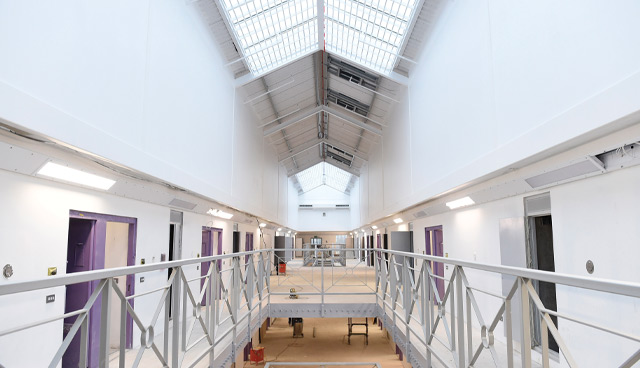Technology: Prisons unlocked

Historically recognised as a sector averse to risk, Northern Ireland’s prison system is undergoing a digital transition and recognising efficiencies through the introduction of innovative technology.
In 2015, Maghaberry Prison, one of Northern Ireland’s three operational prisons, was deemed by inspectors to be one of the most dangerous prisons in the UK. By 2018, inspectors said that the high security prison had undergone a remarkable and one of the quickest turnarounds ever seen.
While the turnaround can be attributed to a combination of changes, the introduction of greater levels of digital technology has played a part, according to Director of Prisons at the Northern Ireland Prison Service (NIPS) Austin Treacy.
Discussing the role of digital technology in the prison system, Treacy sets out challenging conditions in making innovative projects land and effect real change in the period of Executive absence and working with one-year budgets. “It’s not impossible, but it is tough,” he says.
The context for change was a hierarchical prison system adverse to risk. Unsurprisingly, computer systems that existed within such a system were, at best, restrictive in their capability.
The starting point for Treacy and his team was the introduction of finger scanning recognition and visitor bookings. Treacy highlights the value of learnings attained from other prison systems across the UK, where poor specifications were reflected in the eventual product.
With the NIPS system embedded and functioning well, he says that the experience offered an initial taste of what IT could do in an operational setting of a prison. The introduction offered confidence to expand the capability of the biometrical technology further and utilise it to digitise the staff pay-roll. Similarly, PRISM, a software system used to manage inmate information and monitor NIPS performance, was rolled out to secure build PCs in prisoner facing areas for the first time, representing a move away from the traditional model and allowing for information to be put right into the secure landings for staff access.
Treacy is aware that in effecting change, potential opportunities must be seized and identifies one such opportunity as the development of Davis House, a new 360-people capacity block at the Maghaberry site, which represented one of the Northern Ireland Civil Service’s largest capital investments.
Davis House, which was completed in 2019, runs everyday with just 27 prison officers. This is extremely efficient considering the logistics involved in managing the daily routines and movements of 360 prisoners including recreation, meals, learning and skills course attendance and healthcare.
“Our expectations are to be high-performing and we recognise that a big part of this is enabling our staff to facilitate this,” explains Treacy. “Supportive technology is a recognisable way of doing this.
“In assessing that we could run Davis house with 27 staff we looked at the business transactions of everyone in our care. How many transactions do they need every day with our staff and which of those, through the introduction of technology, could be removed.”
The first phase of business improvement was the introduction of in-cell technology for inmates to make their meal requests daily and make tuckshop purchases – worth £750,000 in sales across all prison sites in Northern Ireland annually. A further ambition is to enable automated stock control, ensuring efficiency and benefit to both the consumer and the provider.
Treacy explains that discussions are also underway with their healthcare provider to introduce NHS online, as well as potentially chaplaincy and dental services.
Rapid rollout
While much of this new innovation is centred in Davis House, Treacy is aware of its wider capabilities. “At this minute in time we are also looking at what other parts of our infrastructure are capable of rapid rollout. Where we have been able to access surplus monies, we have initiated retrofitting and cabling in our other facilities in preparation for eventual rollout.
“This ensures that we don’t just see the benefits of digital technology in our showcase building but that the benefits are felt throughout the estate.”
Treacy states that by the end of this year, NIPS aim to be the first prison system in the UK where every cell will have a telephone and in-cell computer system.
“All of these things take away transactions for staff and allow them to focus more on the rehabilitative process for those in their care. That’s the major opportunity.”
A lot of what we have done are seed opportunities and are us taking initial steps and creating a space to build upon the ability of technology within the prison system.
Another potential introduction which NIPS have been examining is the introduction of unescorted, fully automated movement around the site at Maghaberry. Smart turnstiles linked to inmate diaries, which authorises movement between locations. Such an approach would need to be risk managed but also generates greater efficiencies in removing the need for staff escorts and freeing up their time to do more valuable tasks.
Not all technology innovation is linked to the prison’s infrastructure. Body-worn devices have also been utilised. For example, as well as the traditional model, WiFi enabled body worn cameras have been introduced for tactical efficiency, ensuring an incident can be viewed almost instantaneously by the relevant powers at any of the various Department of Justice sites. The prison has also trialled activity trackers, something Treacy says has been successful and beneficial for older persons in their care with limited mobility.
Skype, for trusted prisoners, Google Translate and personal development unit (PDU) tablets have all been recognised as beneficial to operations and efficiencies when provided in portable formats.
Transport
Prisoner transactions often not considered when looking at prison operations are those which take place away from one of the three prisons. NIPS own a fleet of vehicles for prisoner transportation and in 2018 they purchased 13 new vehicles.
Treacy explains: “Again, we saw an opportunity through this investment to analyse the potential of digital technology. We consulted on potential options and one that we liked was that similar to technology used by the ambulance service in introducing mood lighting within vehicles, recognising the impact this can have on people experiencing trauma, anxiety or distress.
“In the same vein, we looked at the potential of information systems within the vehicle. Our new vehicles are the first custody vehicles, either police or prison owned, to have a DVD player, which following a consultation with staff, was recognised as beneficial to those being transported, especially on longer journeys.”
Concluding, Treacy says: “A lot of what we have done are seed opportunities and are us taking initial steps and creating a space to build upon the ability of technology within the prison system. Do I think that an activity tracker is our point of arrival? No, bit it initiates the journey to where we can go and I think it’s a useful first step.
“Underlying it all is our business to make the community safer by supporting and challenging people to change.”






